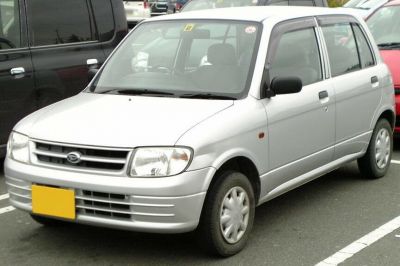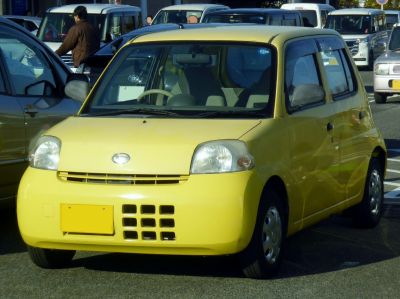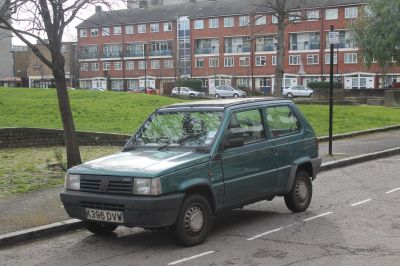 1986 Fiat Panda (ZAF 141, facelift 1986) Dimensions, Size & Specs
1986 Fiat Panda (ZAF 141, facelift 1986) Dimensions, Size & SpecsMeasurements of the 1986 Fiat Panda, engineered for optimal performance and comfort
| Dimensions | |
|---|---|
| Length: | 3410 mm134.3 in11.2 ft |
| Width: | 1490-1500 mm58.7-59.1 in4.9-4.9 ft |
| Height: | 1420-1470 mm55.9-57.9 in4.7-4.8 ft |
| Trunk Capacity: | 272 liter9.6 cu ft |
| Trunk Capacity (Max): | 1088 liter38.4 cu ft |
| Weight Specifications | |
| Curb Weight: | 674-791 kg1486-1744 lbs |
| Maximal permitted Weight: | 1150 kg2535 lbs |
The Fiat Panda ZAF 141 facelift, produced from 1986 to 1991, represents a compact and practical hatchback designed for urban mobility and efficient use of space. This generation of the Panda measures 3410 mm (134.3 inches) in length, with a width ranging from 1490 mm to 1500 mm (58.7 to 59 inches), and a height between 1420 mm and 1470 mm (55.9 to 57.9 inches). Its size makes it an agile vehicle suitable for navigating tight city streets and parking in limited spaces.
The curb weight varies from 674 kg to 791 kg (1486 to 1744 lbs), reflecting its lightweight construction which contributes to fuel efficiency and ease of handling. It supports a maximum weight of 1150 kg (2535 lbs), accommodating passengers and cargo comfortably within its compact footprint.
Regarding storage, the Fiat Panda offers a luggage capacity of 272 liters (9.6 cubic feet), which can be significantly expanded to 1088 liters (38.4 cubic feet) when the rear seats are folded down. This flexibility enhances its practicality, making it suitable not only for daily commuting but also for carrying larger items when needed.
Overall, the Fiat Panda ZAF 141 facelift is an excellent example of a small hatchback from the late 1980s that balances compact exterior dimensions with versatile interior space. Its manageable size, lightweight design, and adaptable luggage volume make it a favored choice for drivers prioritizing economy and functionality in a city car.
Discover the standout features that make the 1986 Fiat Panda a leader in its class
Have a question? Please check our knowledgebase first.
The 1986 Fiat Panda (ZAF 141 facelift) measures 3410 mm (134.3 inches) in length, between 1490 mm and 1500 mm (58.7 to 59.1 inches) in width, and ranges from 1420 mm to 1470 mm (55.9 to 57.9 inches) in height. These compact dimensions emphasize its suitability for urban mobility and easy parking in tight spaces, characteristic of its hatchback design.
The 1986 Fiat Panda has a curb weight ranging between 674 kg and 791 kg (1,486 to 1,744 lbs), which reflects its lightweight construction and efficiency focus. The vehicle's maximum gross weight capacity is 1150 kg (2,535 lbs), allowing for passengers and cargo with a balance that suits city driving and light utility transport.
The luggage compartment of the 1986 Fiat Panda offers 272 liters (9.6 cubic feet) of space with the rear seats in their upright position, which is adequate for everyday shopping or small luggage. When the rear seats are folded down, it expands significantly to 1088 liters (38.4 cubic feet), providing versatile cargo space for larger items or increased storage needs.
Yes, the compact size of the 1986 Fiat Panda makes it very well suited to fit into a standard home garage. Typical residential garages have an interior width of approximately 2.4 to 3.0 meters and a depth of 5.0 to 6.0 meters, which easily accommodate the Panda’s length of 3.41 meters (11.2 feet) and width of about 1.5 meters (4.9 feet), allowing ample space for opening doors and maneuvering.
The slight variation in width from 1490 mm to 1500 mm (58.7 to 59.1 inches) is likely due to different trim levels or minor facelift adjustments. This minor difference has a negligible effect on handling but may slightly enhance shoulder room inside, improving passenger comfort without impacting the vehicle’s compactness and maneuverability.
With a height range between 1420 mm and 1470 mm (55.9 to 57.9 inches), the Fiat Panda offers a relatively tall profile for a small hatchback, which allows for a more upright seating position and improved headroom for occupants. This height also contributes to better visibility for the driver while maintaining a low enough center of gravity to ensure stable handling.
The 1986 facelift version of the Fiat Panda (ZAF 141) retained the fundamental compact dimensions of the original 1980 model but included subtle updates that affected trim and features rather than major size changes. Both generations share very similar length (around 3410 mm), width (about 1490-1500 mm), and weight range (circa 674 to 791 kg). The facelift focused more on aesthetic and mechanical refinements rather than altering the Panda’s trademark size and economy.
Compared to similar compact hatchbacks from the 1980s like the Renault 5, Volkswagen Polo Mk2, or Ford Fiesta Mk2, the 1986 Fiat Panda is slightly more utilitarian with a focus on maximized interior space and simplicity. It is generally comparable in length and width but often lighter, which contributes to its economical fuel consumption. Its boxier shape and higher roofline give it an advantage in interior volume and cargo flexibility, standing out for practical urban and rural use.
The facelifted Fiat Panda ZAF 141 was produced from 1986 until 1991. It primarily targeted European markets, emphasizing affordable, practical, and fuel-efficient transportation. Its design philosophy centered on minimalism, reliability, and versatility, making it popular among city dwellers and rural users alike who sought a no-nonsense compact hatchback.
The 1986 facelift of the Fiat Panda maintained its hatchback body style, favored for its practicality and compactness. While primarily offered in a front-wheel-drive configuration, some versions of the Panda also came with all-wheel-drive systems (notably the 4x4 models), which enhanced its capability and appeal in diverse driving conditions including rougher terrain or inclement weather.
Discover similar sized cars.

| Production: | 2000-2004 |
|---|---|
| Model Year: | 2000 |
| Length: | 3395 mm133.7 in |
| Width: | 1475 mm58.1 in |
| Height: | 1425 mm56.1 in |

| Production: | 2006-2011 |
|---|---|
| Model Year: | 2006 |
| Length: | 3395 mm133.7 in |
| Width: | 1475 mm58.1 in |
| Height: | 1470 mm57.9 in |

| Production: | 2005-2009 |
|---|---|
| Model Year: | 2006 |
| Length: | 3395 mm133.7 in |
| Width: | 1475 mm58.1 in |
| Height: | 1470 mm57.9 in |

| Production: | 1985-1995 |
|---|---|
| Model Year: | 1985 |
| Length: | 3392-3425 mm133.5-134.8 in |
| Width: | 1510 mm59.4 in |
| Height: | 1430-1460 mm56.3-57.5 in |

| Production: | 1991-1996 |
|---|---|
| Model Year: | 1991 |
| Length: | 3408-3435 mm134.2-135.2 in |
| Width: | 1490-1500 mm58.7-59.1 in |
| Height: | 1420-1485 mm55.9-58.5 in |

| Production: | 1985-2013 |
|---|---|
| Model Year: | 1983 |
| Length: | 3335 mm131.3 in |
| Width: | 1440 mm56.7 in |
| Height: | 1410 mm55.5 in |

| Production: | 1998-2001 |
|---|---|
| Model Year: | 1998 |
| Length: | 3395 mm133.7 in |
| Width: | 1475 mm58.1 in |
| Height: | 1450 mm57.1 in |
